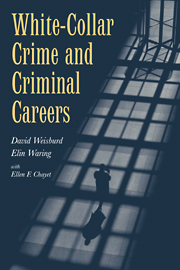Book contents
- Frontmatter
- Contents
- List of Figures
- List of Tables
- Acknowledgments
- Chapter One White-Collar Crime and Criminal Careers
- Chapter Two Dimensions of Official Criminal Careers
- Chapter Three Crimes of Crisis and Opportunity
- Chapter Four Chronic Offenders
- Chapter Five Prison Sanctions and Criminal Careers
- Chapter Six Understanding Recidivism
- Chapter Seven Conclusions
- Appendix A Detailed Information about the Sample
- Appendix B The Imprisonment Model
- References
- Index
Chapter One - White-Collar Crime and Criminal Careers
Published online by Cambridge University Press: 25 June 2009
- Frontmatter
- Contents
- List of Figures
- List of Tables
- Acknowledgments
- Chapter One White-Collar Crime and Criminal Careers
- Chapter Two Dimensions of Official Criminal Careers
- Chapter Three Crimes of Crisis and Opportunity
- Chapter Four Chronic Offenders
- Chapter Five Prison Sanctions and Criminal Careers
- Chapter Six Understanding Recidivism
- Chapter Seven Conclusions
- Appendix A Detailed Information about the Sample
- Appendix B The Imprisonment Model
- References
- Index
Summary
When Edwin Sutherland coined the term “white-collar crime” in his address to the American Sociological Society in 1939, he used the concept to challenge conventional stereotypes and theories. In 1939, crime was generally seen as the work of disadvantaged young men from broken homes and decaying neighborhoods. Through films and books, the criminal was portrayed as a tough guy growing up on the wrong side of town. He was either to be saved by the church or the community or to be condemned to a sad fate determined by the difficult circumstances in which he was raised.
Such stereotypes were not limited to popular images of criminality. In a series of enduring empirical inquiries, sociologists at the University of Chicago in the 1920s and 1930s emphasized the link between social disorganization and poverty in areas within a city and high rates of criminal behavior (e.g., see Thrasher, 1927; Shaw, 1929). Their work, which continues to have an important place in American criminology (e.g., see Reiss and Tonry, 1986), served to focus attention on crimes of the lower classes. When Sutherland gave his ground-breaking speech to the American Sociological Society, scholars and lay people alike saw poverty or conditions associated with poverty as intricately linked to criminality.
Sutherland challenged the traditional image of criminals and the predominant etiological theories of crime of his day. The white-collar criminals he identified were often middle-aged men of respectability and high social status.
- Type
- Chapter
- Information
- White-Collar Crime and Criminal Careers , pp. 1 - 26Publisher: Cambridge University PressPrint publication year: 2001



